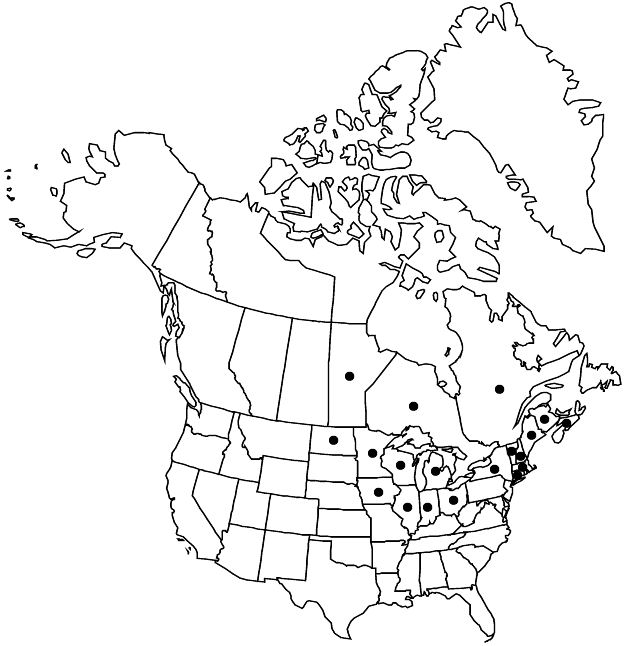Prunus nigra
Hort. Kew. 2: 165. 1789.
Shrubs or trees, sometimes suckering, 30–90 dm, moderately thorny. Twigs with axillary end buds, usually glabrous, rarely hairy. Leaves deciduous; petiole 8–22 mm, glabrate with hairs adaxially, sometimes glandular distally, glands 1–3, discoid; blade broadly elliptic to obovate, (5–)7–11 × 3–6.5 cm, base obtuse to rounded or subcordate, margins doubly crenate-serrate, teeth blunt, glandular, apex abruptly acuminate, abaxial surface hairy along midribs and major veins, adaxial glabrous. Inflorescences 2–4-flowered, umbellate fascicles. Pedicels 7–20 mm, usually glabrous, rarely hairy. Flowers blooming before or at leaf emergence; hypanthium red-tinged, obconic, 3–4(–5) mm, usually glabrous, rarely hairy externally; sepals broadly spreading to reflexed, ovate, 2–4(–5) mm, margins glandular-toothed, abaxial surface usually glabrous, rarely sparsely hairy, adaxial glabrous or hairy; petals white, often fading to pink, suborbiculate to oblong-obovate, 8–13 mm; ovaries glabrous. Drupes red, orange, or yellowish, barely glaucous, globose to ellipsoid, 15–30 mm, glabrous; mesocarps fleshy; stones ovoid-ellipsoid, strongly flattened. 2n = 16.
Phenology: Flowering Apr–Jun; fruiting Aug–Sep.
Habitat: Borders of deciduous woods, bottomland forests, roadside thickets
Elevation: 10–800 m
Distribution

Man., N.B., N.S., Ont., Que., Conn., Ill., Ind., Iowa, Maine, Mass., Mich., Minn., N.H., N.Y., N.Dak., Ohio, Vt., Wis.
Discussion
In the northeastern United States and adjacent Canada, Prunus nigra co-occurs with, and is sometimes confused with, P. americana, despite being distinct in both flower and leaf. The red-tinged hypanthia and sepals of P. nigra give the entire inflorescence a pinkish coloration even when the petals are pure white, and the sepals bear obvious glandular teeth along their margins; in P. americana the hypanthia and sepals are green and the sepals bear relatively few glandular teeth or are eglandular. The leaf marginal teeth of P. nigra are rounded and bear glands at their tips or have callus scars where the glands fell off; those of P. americana are acute and eglandular; some may have a callused tip.
Selected References
None.